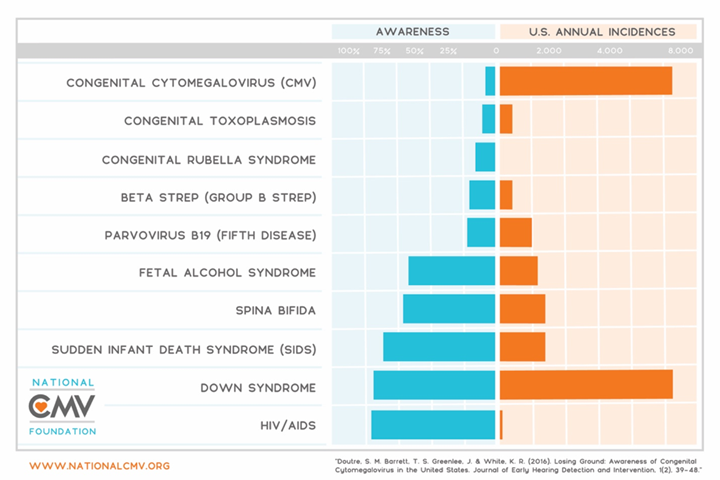CMV awareness is dangerously low as compared to other congenital diseases
 Even though congenital CMV is the leading viral cause of congenital disabilities and the leading non-genetic cause of childhood hearing loss, most adults have never heard of it.
Even though congenital CMV is the leading viral cause of congenital disabilities and the leading non-genetic cause of childhood hearing loss, most adults have never heard of it.
Approximately 0.7%, or 30,000, newborns are born with congenital CMV in the United States every year. Of the newborns with congenital infection, 6,000 will develop permanent disabilities including hearing loss, vision loss, cerebral palsy, or cognitive impairment. Congenital CMV is the leading cause of non-genetic hearing loss. CMV also causes mental retardation, cerebral palsy and many other disabilities.
Pregnant women are most likely to contract CMV from young children and intimate partners. While the CMV virus can live for up to 15 minutes on hands and plastic, and up to 5 minutes on crackers, no viable virus survives after washing hands with water, soap, or sanitizer. The Centers for Disease Control and Prevention (CDC) has recommended pregnant women take measures to reduce their risk of transmitting CMV to their unborn baby.
Women cannot take steps to reduce the risk of transmitting CMV to their unborn baby if they do not know about CMV.
In November 2016, CMV awareness rates for the United States in 2010 and 2015 were published in the Journal of Early Hearing Detection and Intervention. Download the full article here:
http://digitalcommons.usu.edu/jehdi/vol1/iss2/6/.
Highlights from the article:
- CMV awareness is alarmingly low, especially compared to other congenital and childhood conditions with lower incidence rates.
- Public health policymakers and program officials should consider focusing efforts on and directing funds toward increasing CMV awareness and prevention efforts.
- Women have an odds of awareness of one and a half to two times greater than men.
- Hispanics are less than half as likely to be aware of CMV than non-Hispanics.
- The presence of a child ages 0-5 in the household does not increase the chance that an adult in the household is aware of CMV.
What can you do?
- Share information about CMV with your friends and family. Follow the National CMV Foundation on Facebook, Twitter, and Instagram for accurate helpful content.
- Advocate for your state to establish education programs about CMV.
Posted: 6/27/2017
Category: Awareness, "Basic Facts"